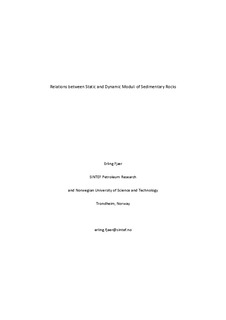| dc.contributor.author | Fjær, Erling | |
| dc.date.accessioned | 2019-08-28T13:08:29Z | |
| dc.date.available | 2019-08-28T13:08:29Z | |
| dc.date.created | 2018-10-09T14:50:00Z | |
| dc.date.issued | 2018 | |
| dc.identifier.issn | 0016-8025 | |
| dc.identifier.uri | http://hdl.handle.net/11250/2611460 | |
| dc.description.abstract | Static moduli of rocks are usually different from the corresponding dynamic moduli. The ratio between them is generally complex and depends on several conditions, including stress state and stress history. Different drainage conditions, dispersion - often associated with pore fluid effects – heterogeneities and strain amplitude are all potential reasons for this discrepancy. Moreover, comparison of static and dynamic moduli is often hampered and maybe mistaken due to insufficient characterization of anisotropy. This paper gives a review of the various mechanisms causing differences between static and dynamic moduli. By careful arrangements of test conditions, it is possible to isolate the mechanisms so that they can be studied separately. Non-elastic deformation induced by the large static strain amplitudes is particularly challenging, however a linear relationship between non-elastic compliance and stress makes it possible to eliminate also this effect by extrapolation to zero strain amplitude. To a large extent, each mechanism can be expressed mathematically with reasonable precision, thus quantitative relations between the moduli can be established. This provides useful tools for analyses and prediction of rock behavior. For instance, such relations may be used to predict static stiffness and even strength based on dynamic measurement. This is particularly useful in field situations where only dynamic data are available. Further, by utilizing the possibility for extrapolation of static measurements to zero strain amplitude, dispersion in the range from seismic to ultrasonic frequencies may be studied by a combination of static and dynamic measurements. | nb_NO |
| dc.language.iso | eng | nb_NO |
| dc.publisher | Wiley | nb_NO |
| dc.title | Relations between Static and Dynamic Moduli of Sedimentary Rocks | nb_NO |
| dc.type | Journal article | nb_NO |
| dc.type | Peer reviewed | nb_NO |
| dc.description.version | acceptedVersion | nb_NO |
| dc.source.journal | Geophysical Prospecting | nb_NO |
| dc.identifier.doi | 10.1111/1365-2478.12711 | |
| dc.identifier.cristin | 1619081 | |
| dc.relation.project | Norges forskningsråd: 234074 | nb_NO |
| dc.description.localcode | Locked until 22.10.2019 due to copyright restrictions. This is the peer reviewed version of an article, which has been published in final form at [https://doi.org/10.1111/1365-2478.12711]. This article may be used for non-commercial purposes in accordance with Wiley Terms and Conditions for Self-Archiving. | nb_NO |
| cristin.unitcode | 194,64,90,0 | |
| cristin.unitname | Institutt for geovitenskap og petroleum | |
| cristin.ispublished | false | |
| cristin.fulltext | postprint | |
| cristin.qualitycode | 1 | |
